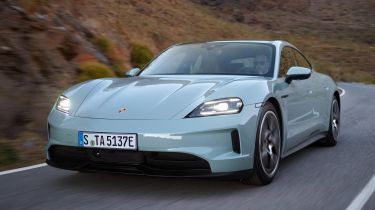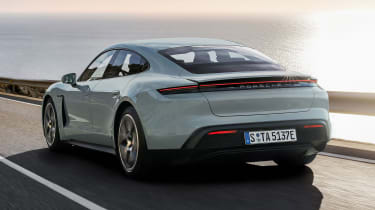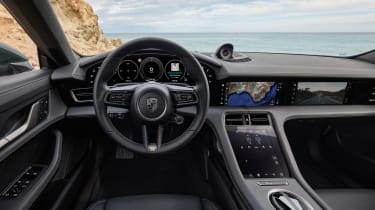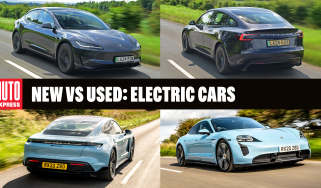Porsche Taycan 2024 updates revealed: 0-62mph in 2.4s with the new 938bhp Turbo S
Porsche’s superstar EV has been given a fresh design and plenty of updates under the skin to keep it on top
Porsche has revealed its faster and fitter Porsche Taycan, featuring substantial upgrades hidden under a light set of aesthetic revisions. The model has been a phenomenal success for the German brand, selling more than 150,000 units since its debut in 2019, so it’s no surprise that Porsche has kept the changes subtle.
Building on what is already a state of the art electric car platform, further development of the Taycan has yielded impressive results with more power, greater efficiency and more capability. That’s before we get into Porsche’s work on the chassis.
Key figures include a much improved 420-mile headline range for the Taycan RWD fitted with the Performance Plus battery. At the other end of the spectrum, meanwhile, the top-spec Turbo S now has an astonishing 938bhp power figure.
Porsche is hoping that these updates will only reinforce the Taycan’s success, keeping it right at the pointy end of the fast-moving high performance EV market. The car will still be available in its three body styles – saloon, Sport Turismo and Cross Turismo – priced from £86,500 for the entry-level rear-wheel drive model and rising to £161,400 for the Turbo S. The updates versions will reach customers in the spring of this year.
Battery and powertrains
Fundamentally, the Taycan rides on the same J1 platform as before with two battery sizes. Porsche’s development work on the larger battery pack, which is the more popular option in most markets, starts with an increase in gross capacity from 93kWh to 105kWh, with the unit arranged in 396 pouch cells. These cells sit in a redesigned housing with composite glass fibre materials for its underbody guard, and all-in it’s 9kg lighter than before, despite the extra capacity.
The new battery pack is paired to substantially upgraded charging hardware now capable of peak charging speeds of 320kW - 50kW more than before. Porsche’s efforts haven’t just gone into hitting these high numbers, but also into improving the Taycan’s ability to make the most of them in the real world. Porsche says the Taycan will comfortably accept more than 300kW charging for stints of more than five minutes at a time, and will ramp up to these charging speeds more quickly and over a wider temperature range.
Despite a 12 per cent increase in battery size, the Taycan will charge from 10 to 80 per cent in just 18 minutes, 4 minutes faster than before. Connect to a 400V charger and speeds are capped at 150kW, and there’s a new controller and software for the 11kW AC in-built charger, which will get the most out of your home wallbox.
Across the range, Porsche has fitted a new rear electric motor that’s 10.4kg lighter than before, but also up to 107bhp more powerful, depending on the model. All Taycans have some level of power increase, starting with the base single-motor RWD Taycan (fitted with the Sport Chrono Package) at 429bhp, which is 26bhp more powerful than before. There’s now 590bhp for the dual-motor 4S (+67bhp) but the big increases are reserved for the Turbo and Turbo S. These flagship models are rated at 871bhp (+200bhp) and a staggering 938bhp (+186bhp), respectively.
Contrary to the rumour mill leading up to the new Porsche Taycan’s reveal, the Turbo and Turbo S don’t feature a triple motor setup, with Porsche engineers instead opting for a more powerful rear motor with a better balance between outright performance and efficiency. As the figures suggest, this doesn’t mean the new top-spec Taycan will be lacking in performance with a 2.4-second 0-62mph time quoted.
A full set of performance figures will be revealed in time, but Porsche’s most dynamic Taycan models are still to come, with the GTS yet to be revealed plus a new Taycan Turbo GT, which has already been setting laps around the Nurburgring.
Chassis and handling
Porsche has also had a fundamental re-think of the Taycan’s suspension systems. The basic layout is the same – hollow-cast aluminium double wishbones up front with a multi-link system out back, but all Taycans are now air-sprung with the basic coil-spring setup no longer available.
The system uses twin-chamber air-springs but matches these to new dual-valve dampers already introduced in the Panamera and soon to find a home in some Audi models, too. This combination widens the range of adjustability between comfort and support, while allowing for variable ride heights that can be optimised for aerodynamics at high speeds.
Above this standard setup is a new Active air suspension system which allows individual control of each damper thanks to its own small electrically-driven compressor. This system negates the need for physical anti-roll bars, and is able to counter roll and pitch at any speed through its complex software. The technology behaves completely differently depending on the chosen driver mode, creating an ultra-comfortable ride at one end of the spectrum while locking down body control entirely at the other.
This system effectively replaces the previous PDCC active anti-roll tech of the previous Taycan while adding even more variability, plus other tricks such as a rapid 55mm access mode that activates when the door is opened.
Porsche’s Torque Vectoring Plus rear differential is fitted as standard on Turbo and Turbo S models – this is able to over-speed the outer rear wheel to augment the car’s cornering balance. Rear-wheel steering is also optional across the range, and fitted as standard on the Turbo S.
Design and interior
What’s been fettled with less on the updated Porsche Taycan is the exterior design, but Porsche has applied enough changes to make it obvious that this is a new model. New front bumpers are fitted as standard across the range, with the Turbo models now featuring their own bespoke units for the first time. There’s also a new range of aero-optimised wheels and tyres at sizes between 19 and 21-inches, and a new colour palette.
Turbo and Turbo S models also feature the new ‘Turbonite’ finish to the exterior detailing and badges first seen on the new Panamera and Macan.
Porsche has introduced new Matrix LED headlights, with optional HD Matrix units that are able to effectively act as projectors, using the beam to highlight potential obstacles or brightening a path representing the car’s physical width as a guide to help squeeze through tight spaces at night.
The cabin isn’t significantly different, but there are updates to the existing digital interfaces accessed via the main 10.9-inch touchscreen and optional passenger display. There is also a new layout option for the curved driver display, but otherwise it remains as before. Porsche is offering new colour and trim options in line with the new Panamera, including an optional leather-free ‘pepita’ and Race-Tex fabric option.
Prices and availability
The updated Porsche Taycans will be available in the same three optional body-shapes as before, made up from the saloon, Sport Turismo estate and higher-riding Cross Turismo. The range structure remains as before, too, with the aforementioned GTS still to be revealed. Powertrain options are identical right through the three body options, save for a unique Taycan 4 option specific to the Cross Turismo.
The new Taycan is available to order now with prices for the base model starting at £86,500 for the single-motor saloon, rising to £95,900 for the 4S and £134,100 for the Turbo. The Turbo S tops the range at £161,400, while spec-for-spec the Sport Turismo will command a further £800 and the Cross Turismo an extra £1,100.
Click here for our list of the best performance cars...
Find a car with the experts









